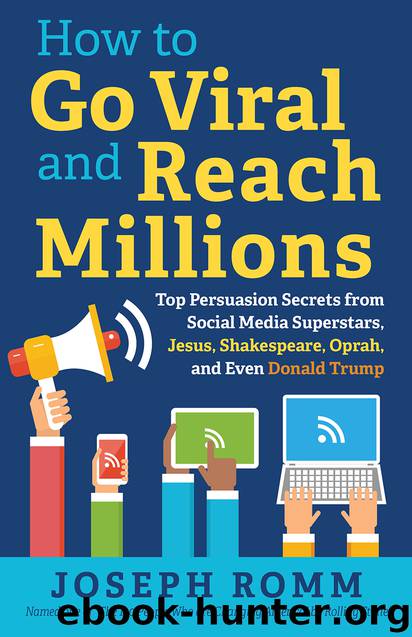How To Go Viral and Reach Millions: Top Persuasion Secrets from Social Media Superstars, Jesus, Shakespeare, Oprah, and Even Donald Trump by Romm Joseph

Author:Romm, Joseph [Romm, Joseph]
Language: eng
Format: epub
Publisher: Luminare Press
Published: 2018-05-29T16:00:00+00:00
CHAPTER SEVEN
Metaphors Are like Warp Drive: The Viral Power of Proto-Stories
The greatest thing by far is to be a master of metaphor….
—Aristotle, Poetics
Our ordinary conceptual system, in terms of which we both think and act, is fundamentally metaphorical in nature.
—George Lakoff and Mark Johnson, Metaphors We Live By , 1980
The human species thinks in metaphors and learns through stories.
—Mary Catherine Bateson, Peripheral Visions , 1994
Good metaphors are the Starship Enterprise of figures—they take you from where you are to a completely different place at light speed. But, metaphors can be more like the Millennium Falcon, since as powerful as they are, sometimes they are rickety and don’t work. Metaphors are also like a tornado that takes you from Kansas to Oz, a place at once utterly different and yet filled with familiar-looking faces.
At the heart of every story that touches us is a metaphor, something that connects us to the story deeply. We aren’t living “a long time ago in a galaxy far, far away” or in a Star Trek future centuries from now or in Oz or Hogwarts or Wakanda or Gotham. But we still can identify with and imagine ourselves as Luke or Leia or Han, Kirk or Spock or McCoy, Harry or Hermione or Ron—or Black Panther. We aren’t literally superheroes, but we can figuratively aspire to have a hero’s journey. As the viral internet meme says, “Always be yourself, unless you can be Batman. Then always be Batman.”
Metaphors are so powerful and so universal because they are the most essential of the mental shortcuts that allow us to make sense of the world and quickly figure out the best action in different situations, especially ones we haven’t seen before. Because human brains are small and our lifespan was especially short when we were evolving, our brains were “forced to rely on tricks to enlarge memory and speed computation,” as E. O. Wilson explained in Biophilia . That’s why our mind “specializes on analogy and metaphor” for pattern matching.
Pattern matching is most useful when it helps answer this question: How does my current problem or situation resemble another one that I have seen or heard about before? But that’s precisely the job of a metaphor. It connects a known situation to an unknown or novel one. How do we make sense of a concept like God? “The Lord is my shepherd” begins Psalm 23. Who is Alexander Hamilton? “I’m just like my country, I’m young, scrappy and hungry. And I’m not throwing away my shot,” as his character repeats again and again in his signature song in Lin-Manuel Miranda’s viral musical. How can we make sense of Marilyn Monroe’s and Princess Diana’s tragic deaths? Each was like a “Candle in the Wind,” as Elton John sings in his eulogy to Diana (a revision of his eulogy to Monroe), which became one of the best-selling singles in history.
But the true power of a great metaphor is, that like a powerful warp drive, it doesn’ t just take us on a single trip, but can keep the journey going where no one has gone before.
Download
This site does not store any files on its server. We only index and link to content provided by other sites. Please contact the content providers to delete copyright contents if any and email us, we'll remove relevant links or contents immediately.
Cecilia; Or, Memoirs of an Heiress — Volume 1 by Fanny Burney(32375)
Cecilia; Or, Memoirs of an Heiress — Volume 3 by Fanny Burney(31750)
Cecilia; Or, Memoirs of an Heiress — Volume 2 by Fanny Burney(31715)
The Great Music City by Andrea Baker(31087)
We're Going to Need More Wine by Gabrielle Union(18906)
All the Missing Girls by Megan Miranda(15392)
Pimp by Iceberg Slim(14213)
Bombshells: Glamour Girls of a Lifetime by Sullivan Steve(13928)
Talking to Strangers by Malcolm Gladwell(13134)
Norse Mythology by Gaiman Neil(13126)
Fifty Shades Freed by E L James(13121)
For the Love of Europe by Rick Steves(12345)
Crazy Rich Asians by Kevin Kwan(9124)
Mindhunter: Inside the FBI's Elite Serial Crime Unit by John E. Douglas & Mark Olshaker(9104)
The Lost Art of Listening by Michael P. Nichols(7360)
Enlightenment Now: The Case for Reason, Science, Humanism, and Progress by Steven Pinker(7084)
The Four Agreements by Don Miguel Ruiz(6542)
Bad Blood by John Carreyrou(6477)
Weapons of Math Destruction by Cathy O'Neil(6085)
